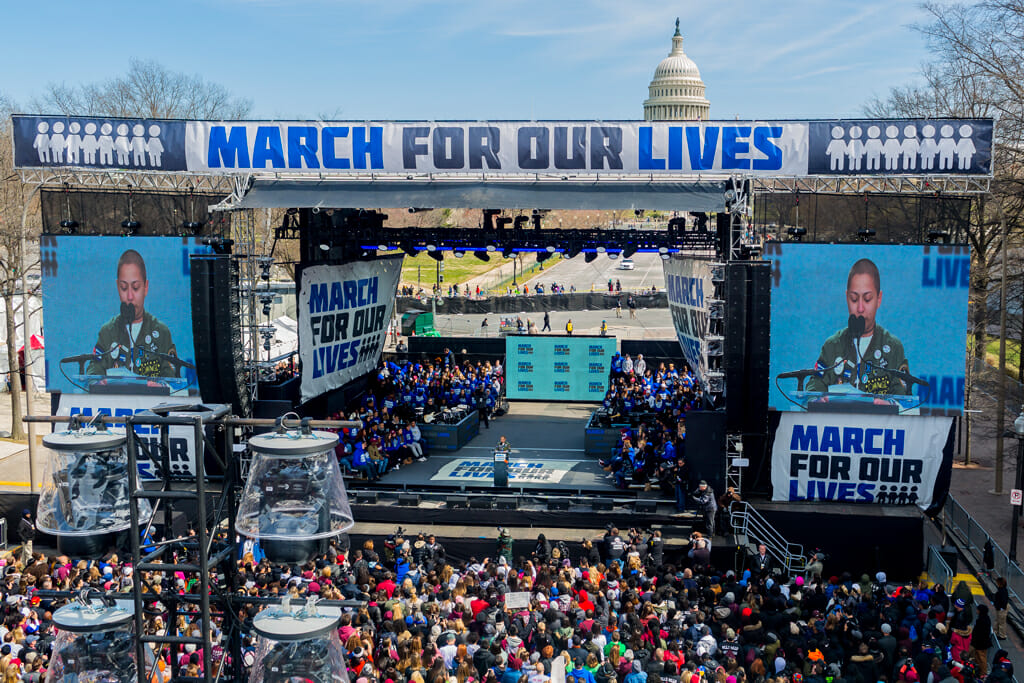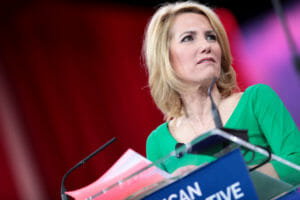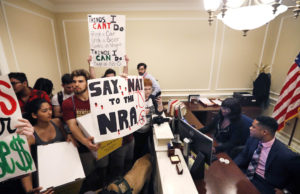‘After Parkland’ and the Pervasive Toll of School Shootings
From avoidance to activism, a new documentary follows how student survivors and grieving parents coped after the tragedy in Florida. Attendees at the 2018 March for Our Lives rally in Washington, D.C., look on as Parkland shooting survivor Emma Gonzalez takes the stage. (Michael Nigro / Truthdig)
Attendees at the 2018 March for Our Lives rally in Washington, D.C., look on as Parkland shooting survivor Emma Gonzalez takes the stage. (Michael Nigro / Truthdig)
Correction updated, Feb. 21, 10:10 a.m. Pacific time: This story has been updated to reflect Saugus High School student Jaimee Roeschke never said in an interview with CNN, “Yes. I always thought there’d be a shooting at our school.” Her sister Madi in the same interview is quoted below.
It took me a few days to RSVP to the screening of the documentary, “After Parkland.” It wasn’t that I didn’t want to see this important film; it was that the school shooting at Marjory Stoneman Douglas High School in Parkland, Fla., held a personal tie. My son’s preschool friend, C.J. Orr, was one of the students forced to hide while listening to the gunshots from the second-floor classroom next to his. After the gunfire stopped, the then-sophomore emerged from a classroom closet with others and had to step over the bodies of his friends. Fourteen students and three school staff members were killed on that Valentine’s Day in 2018 by a gunman with a semi-automatic rifle.
A few days after the shooting, journalists Emily Taguchi and Jake Lefferman, originally in town for ABC’s “Nightline,” began filming a documentary to chronicle what followed the tragedy. Produced by Kino Lorber and ABC Films, it focuses on student survivors and grieving parents, delving into how they were coping and what they planned to do to try to stop other school shootings.
Over several months, the filmmakers followed Parkland student survivors to school, their homes, basketball games, a prom and their graduation. They also talked to Andrew Pollack, whose only daughter, Meadow, was fatally shot at point-blank range while trying to shield a freshman, and to Manuel and Patricia Oliver, whose 17-year-old son, Joaquin, was killed at Parkland.
The story opens with Pollack. Shortly after the shooting, he was invited to the White House, along with senior Sam Zeif, who had been desperately texting his 14-year-old brother at the school while the gunman was still shooting. Zeif’s brother, who survived, was in a classroom in which a teacher and his best friend were killed. Also invited to Washington, D.C., to meet with President Donald Trump were some of the parents of victims of fatal school shootings at Columbine High School in Colorado and Sandy Hook Elementary in Connecticut.
In the documentary, Zeif, sporting a goatee and clearly shaken, asks Trump, “How can this still happen? How is it that someone can still enter a store after Columbine and Sandy Hook and buy an assault rifle? … How can a 20-year-old walk into a gun store and purchase an AR-15 rifle in five minutes with an expired ID? In Australia, there was a shooting at a school in 1999. They put legislation together and they stopped it. So let’s be strong, and let’s never let this happen again. Please. Please.” Trump shakes his head yes, and then does nothing.
We see that Manuel Oliver has somehow managed to channel his pain in losing his son Joaquin into coaching basketball and painting. He coerced Joaquin’s best friend from elementary school, Dillon McCooty, to step up in his son’s spot for the team. The graphic artist also is seen in Chicago painting a mural of his slain son, as he quickly learns it’s harder to purchase spray paint than a gun.
Joaquin Oliver had moved to the U.S. from Venezuela when he was 3. He loved sports, R&B and his friends, who called him by the nickname “Guac.” His girlfriend, Victoria Gonzalez, prayed during the shooting that he’d be OK. “My whole future was wiped out,” she said. “Every day that passes I feel further from him.”
A little more than a month after the shooting, a group of Parkland students gathered to fight against gun violence. About 2 million people attended the student-led March for Our Lives rally in Washington, D.C., and its 880-plus sister demonstrations across the country, making it one of the largest protests in American history.
Several students gave impassioned, heartbreaking speeches. A highlight was Emma Gonzalez, one of several founders of the “Never Again” movement created after the shooting, who gave a viral speech against gun violence that called “B.S.” in response to gun laws. At the rally, Gonzalez led a moment of silence for the victims of the massacre, then stood silent for more than six minutes—the length of the shooting spree.
Unfortunately, Gonzalez and other students in the movement had to deal with deniers. For example, Leslie Gibson, a Republican candidate for the Maine State House, described González as a “skinhead lesbian.” Gibson also insulted David Hogg, another founding member of “Never Again MSD” who became a high-profile gun-control advocate, as a “bald-faced liar.”
Hogg, who is seen frequently in the documentary and whose younger sister Lauren lost four of her friends in the shooting, became one of several Parkland students targeted and scapegoated on social media. Because his father was a former FBI agent, Hogg became the focus of conspiracy theorists claiming he was a fake, or “a crisis actor.”
“I’m someone who had to witness this [the shooting] and live through this and I continue to be having to deal with that,” Hogg told CNN’s Anderson Cooper on “AC360.” “The fact that they’re calling me out as a witness of this horrifying incident, that I’m a crisis actor? … I feel for those people, honestly.”
The documentary continues on to prom time, showing several student survivors getting ready together. Dillon McCooty escorts Joaquin Oliver’s girlfriend, Victoria Gonzalez, knowing his best friend “Guac” would have wanted it that way.
Pollack stops by, but it appears it is too much for him to handle, knowing his daughter Meadow should have been there. He doesn’t attend the graduation either; Meadow had planned to attend Lynn University in Boca Raton, Fla., that fall. We last see Pollack walking his German shepherd into an empty playground. This gave him the idea to fix up the park in memory of his slain daughter.
For his part, Manuel Oliver is producing a one-man social justice theater tour of “Guac: My Son, My Hero.” Leading up to the November 2020 election, Oliver plans to take his show to key electoral states to fight for sensible gun reform.
“After Parkland” will be released in theaters across North America in early 2020 around the two-year anniversary. The accused Parkland shooter, a former student at the school, is in jail awaiting trial on murder and attempted murder charges.
Other Parkland Stories Told
What happened to the other students who survived and are left to remember that harrowing day? A teacher and a few students moved to other schools. In “Parkland: Birth of a Movement,” by Dave Cullen (who also wrote “Columbine“), the author notes how painful and frightening it can be to go back to a terrorized school. “The high school felt like a crime scene: Helicopters hovered, the chopper triggered anxiety and panic for some who heard the motors over their school on the shooting,” he writes. “One student noted he and his friends heard a car engine go pop pop pop, ‘and we all started hyperventilating.’ ”
Shortly after the shooting, teacher Diane Wolk-Rogers created a Mind Body Club. C.J. Orr, a sophomore who was forced to hide in the closet during the shooting and a longtime friend of my son, became involved in the club. “School can be overwhelming, especially dealing with trauma, stress and anxieties,” he said. Through tears and heartbreak came activism and new ways of healing. Many eventually felt they could be strong once again.
Nothing Has Been Done to Stop the Carnage
Five days before the screening of “After Parkland,” a gunman fatally shot two classmates at Saugus High School in Santa Clarita, Calif., and injured three other students before shooting himself with an unregistered “ghost” handgun, which can be bought online and at gun shows.
Amanda Osler and her younger brother Brandon were in the library when they heard what sounded like a balloon popping. Multiple shots then rang out. They didn’t know where to go, so they ran out of the school, which is surrounded by homes. “We were told that there was an active shooter and to get out of school and find a house,” recalled Amanda. After knocking on a couple doors, two women pulled them inside their home. Amanda was given a comfort blanket. “Yes, I was nervous and scared, but I felt comforted.”
A poignant scene unfolded as the father of Gracie Muehlberger, one of the students killed, spoke about the loss of his only daughter—the girl he called “Sweet Pea”—as his two sons stood by his side. It brought to mind Andrew Pollack reflecting on the death of his daughter, Meadow, at Parkland.
A few days after the mass shooting at Saugus on Nov. 14, sisters Jaimee and Madi Roeschke appeared on CNN. Reporter Alisyn Camerota asked Madi whether she feared that this could someday happen at her school, and she replied, “I definitely wasn’t surprised that it happened.”
Students at Saugus had been among the many who joined nationwide walkouts in March 2018 in the wake of the Parkland shooting, leaving their classrooms for 15 minutes to protest gun violence, reported the Santa Clarita Valley Signal.
Administrators at Saugus immediately received phone calls from schools across the country that had experienced similarly horrific incidents. A school shooting expert, Dr. David Schonfeld, was brought in. The developmental-behavioral pediatrician and USC professor has held two presentations for parents, as well as meetings with administrators and trainings for staff. “It’s designed to help adults support and guide students navigating grief and trauma,” Schonfeld said.
“These are not trivial events, even for kids who weren’t directly involved. … I don’t think people realize all the ramifications and things you need to consider,” said Schonfeld, who has been involved with virtually every one of the incidents, from Sandy Hook Elementary to Marjory Stoneman Douglas High School.
Saugus High School classes resumed after Thanksgiving break for the first time since the shooting.
Support Remains High for Gun Control
To date, the Gun Violence Archive has recorded more than 370 mass shootings in the U.S. in 2019, an average of eight mass shootings a week. A majority of Americans say gun laws should be stricter than they have been.
California has banned assault weapons and high-capacity magazines and prohibits high-risk individuals and domestic violence offenders from purchasing weapons. Universal background checks are also required. Connecticut, where the devastating Sandy Hook shooting occurred, enacted the same gun control laws.
Your support matters…Independent journalism is under threat and overshadowed by heavily funded mainstream media.
You can help level the playing field. Become a member.
Your tax-deductible contribution keeps us digging beneath the headlines to give you thought-provoking, investigative reporting and analysis that unearths what's really happening- without compromise.
Give today to support our courageous, independent journalists.



You need to be a supporter to comment.
There are currently no responses to this article.
Be the first to respond.